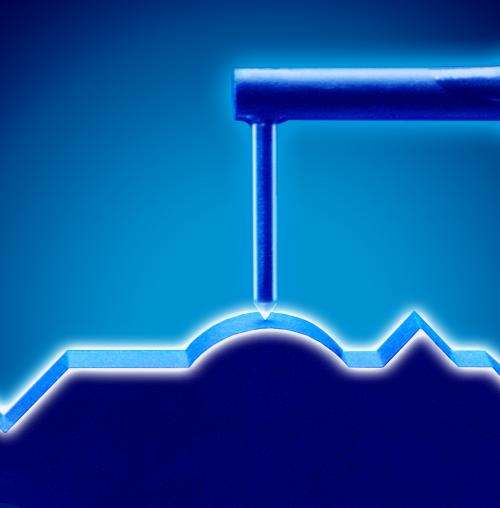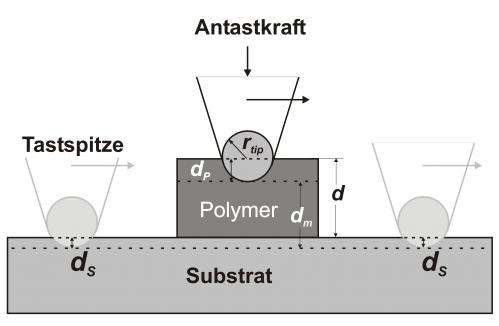Precise thickness measurement of soft materials by means of contact stylus instruments

In microsystems, metallic components are increasingly replaced by components made of inexpensive polymers. As polymers yield when they are subjected to pressure, the layer thicknesses cannot be measured with sufficient accuracy by means of conventional contact stylus instruments. But precision is of decisive importance in microsystem technology. Here, the scientists of the Physikalisch-Technische Bundesanstalt (PTB) come into play: In the medium term, industrial enterprises which measure the thickness of soft polymer layers on hard substrates will be able to correct their measurement results by means of a formula.
From the motion sensor to the computer chip - in many products of daily life components are used whose functioning is based on smallest structures of the size of thousandths of millimetres. Here, the measurements must be exact so that in the end, the overall system will work smoothly. To be able to continue to measure also thin layers of elastic polymers on hard substrates dimensionally by means of contact stylus instruments, PTB has developed a procedure for the correction of the measurement results in cooperation with other European metrology institutes. The scientists have mainly investigated the properties of the widely used Photoresist SU-8 as well as the Polymer Ormocomp used for the manufacturing of microoptics.
In the case of such soft materials, the contact force, the stylus tip radius and the traverse speed have an influence on the deformation of the component and, thus, on the measurement result. Hence, for the modelling of the observed systematic errors of tactile layer thickness measurements, a model with nonlinear strain hardening has been chosen which takes into account elastic, plastic and viscous deformations. In a next step, the viscoelastic-plastic model will be extended so that the ageing of polymers can also be taken into account.

On the one hand, the results of this work shall enter into a standard and, on the other hand, they shall supply industry with a practical auxiliary means to correct their measurement results. The research work takes place within the scope of the international MeProVisc project (dynamic mechanical properties and long-term deformation behaviour of viscous materials) which forms part of the European Metrology Research Programme (EMRP) and will presumably have been completed by the end of 2014.
More information: Brand, U. et al. Comparison of optical and tactile layer thickness measurements of polymers and metals on silicon or SiO2, Meas. Sci. Technol. 22 (2011) 094021 (14pp). www.ptb.de/cms/fachabteilungen … richt.html?tx_ttnews%5btt_news%5d=5331&tx_ttnews%5bbackPid%5d=752&cHash=8785cc4ce559c031c3100e7b4cdf5e8b
Provided by Physikalisch-Technische Bundesanstalt



















